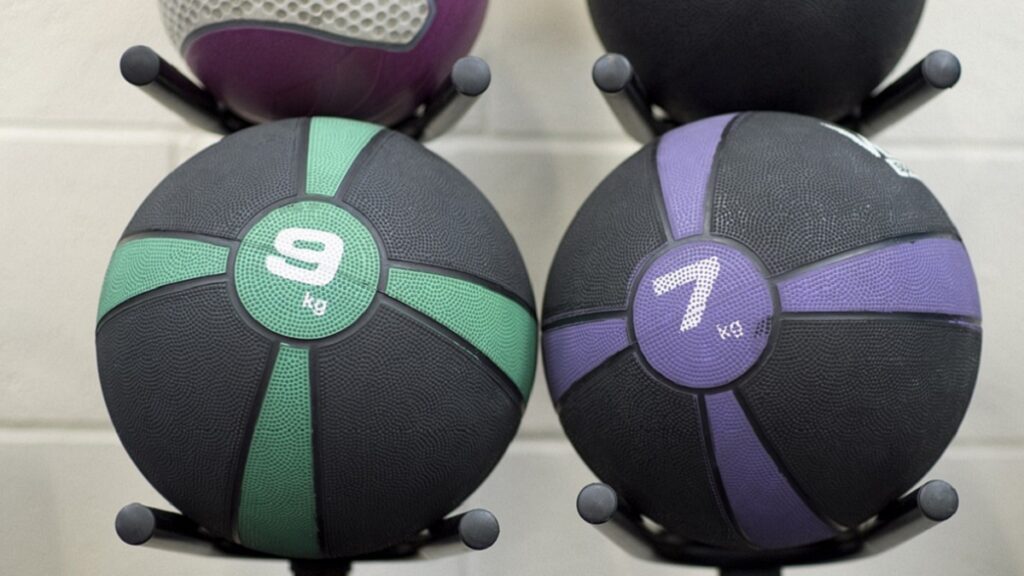Isotonic exercise for shoulder gradually gives strength and endurance to the shoulder muscles by continuously forcing them to resist the force it creates. Dumbbells and resistance bands are the most commonly used tools to boost muscle tension during such exercises. Examples of isotonic exercises for the shoulder include shoulder presses, dips, biceps curls, and shoulder raises to mention but a few.
During an isotonic exercise, your muscle shortens and lengthens in turns while you move your limb through different ranges of motion. Isotonic shoulder exercise involves the contracting and relaxing shoulder muscles by resisting weight through a full range of motion. The two forms of isotonic exercises are concentric and eccentric contractions.
Read on for a better insight into isotonic exercises!
What Kind of Exercise is Isotonic?
An isotonic exercise is a dynamic exercise where the length of your muscles keeps changing, but the muscle tension remains constant during the workout. Unlike in isometric exercise, where your muscles undergo tension without visible movement, there is a lot of movement in isotonic exercises.
For instance, when you curl your biceps, there is a repetitive flexion of your elbow joint. When you lift the weight towards the shoulder, the biceps muscle shortens but lengthens when you gently lower the weight towards the pull of gravity.
More examples of isotonic exercises are squats, leg presses, lunges, sit-ups, pull-ups, push-ups, and bench presses. In addition, aerobic exercises like walking and swimming involve muscle movement and are thus isotonic.
Resistance bands, weight machines, and free weights (like dumbbells) form part of isotonic exercises so as to boost muscle resistance. Apart from strengthening your muscles, such exercises build your muscle endurance.
According to Dr. Bailey, the weights and resistance bands are gradually added to challenge your muscles further as they gain more strength. You should incorporate Isotonic exercises into your fitness programs to keep your body healthy and in good shape.
Is Isotonic Exercise Beneficial to The Body?
Yes, isotonic exercises benefit your body in several ways. Due to the increased movement of limbs, joints, and muscles, the heart rate and oxygen consumption increases. Thus, the cardiovascular system strengthens, decreasing the risk of heart disease.
Furthermore, the consistent stress on bones triggers the formation of new bones. As a result, bone density increases. A bone with high density is stronger and less likely to suffer a bone fracture.
The muscle contractions during isotonic exercises burn calories and keep blood sugar and cholesterol in check.
Ultimately, isotonic exercises offer a helpful way to rehabilitate the body by regaining muscle strength and the shoulder joint’s range of motion after injury. In this way, the shoulder pain is alleviated. Besides, it is helpful for weight management and boosting the stamina of athletes’ bodies.
Isotonic Exercise for Shoulder
Isotonic exercise for the shoulder activates the shoulder muscles while moving the shoulder joint. Your muscles are strengthened by their varying length during the exercise. Isotonic exercises for the shoulder joint involve using weight resistance tools like dumbbells, resistance bands, and cables that help you apply a constant measure of weight.
Strengthened shoulder muscles help you efficiently perform daily tasks like lifting, carrying, and raising your arms above your head. Isotonic exercises at the shoulder usually target the biceps brachii, subscapularis, and teres major muscles.
The coracobrachialis muscle close to the head of the humerus is also involved when bending the arm or moving it close to your body.
Although isotonic shoulder exercises are beneficial, it is wise to perform them when you are in proper form. Some exercises may be too extreme if you are recovering from an injury. It is advisable to seek the advice of a physical therapist to see you through the recovery journey.
Examples Of Isotonic Exercises for The Shoulder
There are several dynamic exercises for the shoulder.
Shoulder Abduction Using Dumbbells
Abduction exercises involve moving your limbs away from your trunk. Thus, shoulder abduction exercises involve raising your arms away from your body. The movement is also known as a lateral raise.
To increase muscle tension, you hold some weight, such as a dumbbell. However, you must consult your healthcare provider on the right size hand weights for your arm. You may need a lighter weight if your shoulder is recovering from injury.
Below are the steps to a perfect shoulder abduction using a dumbbell.
- Stand up and move your feet slightly apart. Let the distance between your feet be roughly the same as your shoulder width. Then, hold the weights on either arm and drop the arms freely at your sides. The arms must remain taut during the exercise, but the elbow is unlocked.
- Move your arms out to the side of your body and gently raise them until the weights in your hands are at shoulder level, and pause for a moment. Now gently lower your arms to their starting position.
- Repeat the exercise 5-10 times.
Safety tip: Do not raise the weights above shoulder level or move the arms swiftly.
Shoulder Press
The shoulder press is an isotonic exercise that strengthens the shoulder joint by activating the upper back, triceps, and deltoid muscles. Besides boosting the shoulder joint’s mobility and stability, it boosts upper body strength.
There are two major ways of performing the shoulder press:
The Barbell Shoulder Press
To perform this kind of exercise, follow these three simple steps:
- Stand with your feet apart and hold a barbell with the palms of your hands facing away from your body. Let the distance between the right hand and the left hand be equal to your shoulder width. First, support the barbell with your chest.
- Then, lift the barbell straight up to the top of your head by straightening your elbows.
- Hold the position for three seconds and lower the barbell to shoulder height for some rest. You may repeat the process 10 times.
This is what fitness experts refer to as the overhead shoulder press. If done correctly, it strengthens the muscles supporting the shoulder blades and improves general shoulder stability.
However, if you elevate the shoulder blades or shrug your shoulders, you stress the shoulder joint. This can cause injury. Thus, choosing the proper form and weight to benefit from the exercise is essential.
The push press is similar to the overhead press. The only difference is that the push press goes along with some flexion movement at the knees to give you some momentum to push the barbell overhead.
The Seated Shoulder Press
To perform the seated shoulder press, follow these steps:
- Sit upright on a bench with back support.
- Grab the weights (dumbbells) with the palms of both hands facing each other. With the elbows bent, bring the weights to the level of your chin.
- Press both weights upwards (in a straightforward manner) until your arms straighten. However, you should not let your elbows lock. Pause for a moment at that position.
- Now lower your weights back to your chin level for rest. Repeat the exercise ten times. This is what is known as the front shoulder press.
Front Shoulder Raises
Front raises are isotonic shoulder exercises using resistance bands or dumbbells to activate the anterior deltoid muscles. However, it is crucial to begin with a light dumbbell or a flexible resistance band and build up slowly to avoid injury.
These are the steps for a good shoulder raise.
- Stand upright with your legs slightly apart. Allow a slight bend on your knees.
- Hold the dumbbells, one on each palm or resistance cable, on either side of the band, keeping your arms straight.
- Now raise your arms directly in front of your body. Persevere the weight resistance without bending your elbows.
- Pause at that position momentarily and lower your arms to the initial position.
- Repeat the process ten times.
Which Are Two Forms of Isotonic Exercises?
The two forms of isotonic exercises are concentric and eccentric isotonic contractions.
The concentric contractions occur when your activated muscle absorbs tension and shortens as it contracts. Most daily activities, like lifting objects, utilize this kind of muscle contraction. Once the muscle shortens, it produces a force that can move or lift the object. Concentric exercises include lifting a dumbbell to your shoulder (bicep curl), shoulder press, leg press, dips, and extending from a press up. Such exercises are effective in boosting muscle strength.
On the other hand, eccentric contractions occur when the length of the activated muscle increases as it contracts. In an eccentric exercise like lowering a dumbbell, your muscle fiber stretches under tension. The muscle lengthens because the force applied to it is usually more significant than the force it produces in reaction, and thus, the joint is pulled on the opposite side of contraction. The muscle works to slow down the downward movement of the lowered weight.
All eccentric exercises lower the weight during a leg press, bicep curl, dip, or shoulder press.
Exercises that combine the two muscle contractions give faster and better results for strength training.
What Are 5 Isotonic Exercises?
The isotonic exercises include the Bicep curl, leg press, push-ups, squatting, and walking. Let us see what they entail and the muscle movements that make them isotonic.
Bicep Curl: Bicep curls activate the bicep muscle when you lift weights towards the shoulder by bending the elbows.
Leg Press: You sit on a machine with your back supported to perform a leg press. You then place your feet against the weight platform. You push the platform away and control it with your feet as it presses back to the starting position. It causes contraction and relaxation of the leg muscles.
Push-ups: These are commonly known as press-ups. They involve lying on the floor and raising your body by pressing down on your hands and lowering them to the starting position.
They are strenuous isotonic exercises that cause the movement of multiple muscles in the chest, shoulders, and triceps. They also engage the leg and back muscles.
Squatting: Squatting imitates the movement of sitting down and standing up. The knees are bent, the hips lowered, and the back is kept straight while squatting down. The opposite happens when squatting up.
Surprisingly, a static squat becomes an isometric exercise.
Walking: Walking fits perfectly into the isotonic exercise category since it involves consistently contracting and relaxing leg muscles. Furthermore, the ankle, knee, and hip muscles move through their range of motion.
What Are 3 Shoulder Exercises?
The three shoulder exercises are the side-lying rotation, bent-over rows, and cable flyes. They help strengthen your joint shoulder muscles and make daily activities like carrying and lifting easier. Besides, they improve your posture.
Side Lying External Rotation
To perform this exercise, lay on your side on a bench and support the dormant elbow with a pillow. Now bend the other free elbow to 90 degrees and then use it to raise a small dumbbell by rotating the shoulder.
The starting point should be the bench’s surface from where you lift the dumbbell. Repeat the exercise at least ten times. Three sets of ten are ideal.
Bent Over Rows
These are exercises meant to strengthen the rotator cuff tendons. They are best performed with a dumbbell.
To exercise your left arm, lean over and rest your right arm on a bench. You may also rest your right knee against the sides of the bench for more support.
Lift the weight with your left hand without rounding your back and bring it towards your ribs. To perform the exercise well, ensure you press your shoulder blades together by forcing your elbow back.
You must hold the weight near the ribs for 2-3 seconds while squeezing your shoulder muscles. Drop the weight to the starting position while still squeezing your shoulder muscles to control the decline. Repeat the exercise at least 10 times.
Cable flyes
Cable chest flyes activate the shoulder and chest muscles using a cable machine or resistance band. They are performed by outstretching your arms to the side.
You can perform the exercise while standing or seated. Each arm holds one end of a resistance band or cable.
Pull the ends together with your elbows slightly bent until your hands meet in front of your chest. Cable flyes improve the shoulder’s range of motion and strength.
What Is Isotonic Exercise in Physiotherapy?
Isotonic exercise in physiotherapy is a movement that causes a change in the length of a muscle due to the muscle’s resistance to weight over its normal range of motion. According to Dr. Mellisa Stoppler, an isotonic exercise is one of the muscle exercises whereby the activated muscle shortens against a constant weight or load.
An isotonic exercise may either be concentric or eccentric. When it is concentric, the muscle fibers reduce in length (shorten) as they exert force. However, when it is eccentric, the muscle fibers lengthen as they exert force.
A combination of these two types of movements is used in physiotherapy to restore muscle strength.
What Are The 3 Examples of An Isometric Exercise?
Three examples of isometric exercises are wall sits, side planks, and the low squat. All three exercises involve isometric contractions where tension rises in the activated muscle, but the length of the muscle remains the same.
Although the muscle works and exerts some force, its length remains unchanged. That is why all isometric exercises involve a static position for a specified time.
FAQs
Is Shoulder Press Isometric or Isotonic?
A shoulder press may be either isometric or isotonic. It is isotonic when you push the weight from your chest to the level above your head since the shoulder and arm muscles change in length. However, it becomes isometric when you hold the weight at a fixed position above your head because the muscle length does not change.
What Is the Best Exercise for Shoulder Pain?
The particular cause of the pain determines the best exercise for shoulder pain. It is advisable to consult a physical therapist to diagnose the pain and customize an exercise program for you. However, most therapists prescribe shoulder blade squeeze, pendulum exercises, and gentle range of motion exercises for shoulder pain.
Isometric shoulder exercises, where you contract the muscles without moving the joint, also help reduce pain and regain strength during recovery from injury.
Conclusion
Isotonic exercise for shoulder is crucial for maintaining and restoring a healthy and strong shoulder. It increases joint mobility and builds muscle strength when rehabilitating your shoulder from a recent injury.
Besides, the exercises may help reduce the likelihood of strain injury by boosting muscle strength, endurance, and coordination.
The ideal frequency for isotonic exercises is 2-3 times a week. You may increase it to 3-4 times once your muscle strength improves. However, it is essential to consult a fitness expert on the appropriate frequency and intensity of the exercises depending on the state of your joints.



